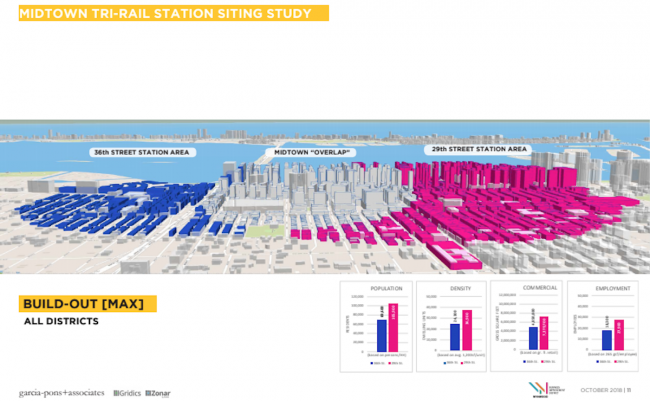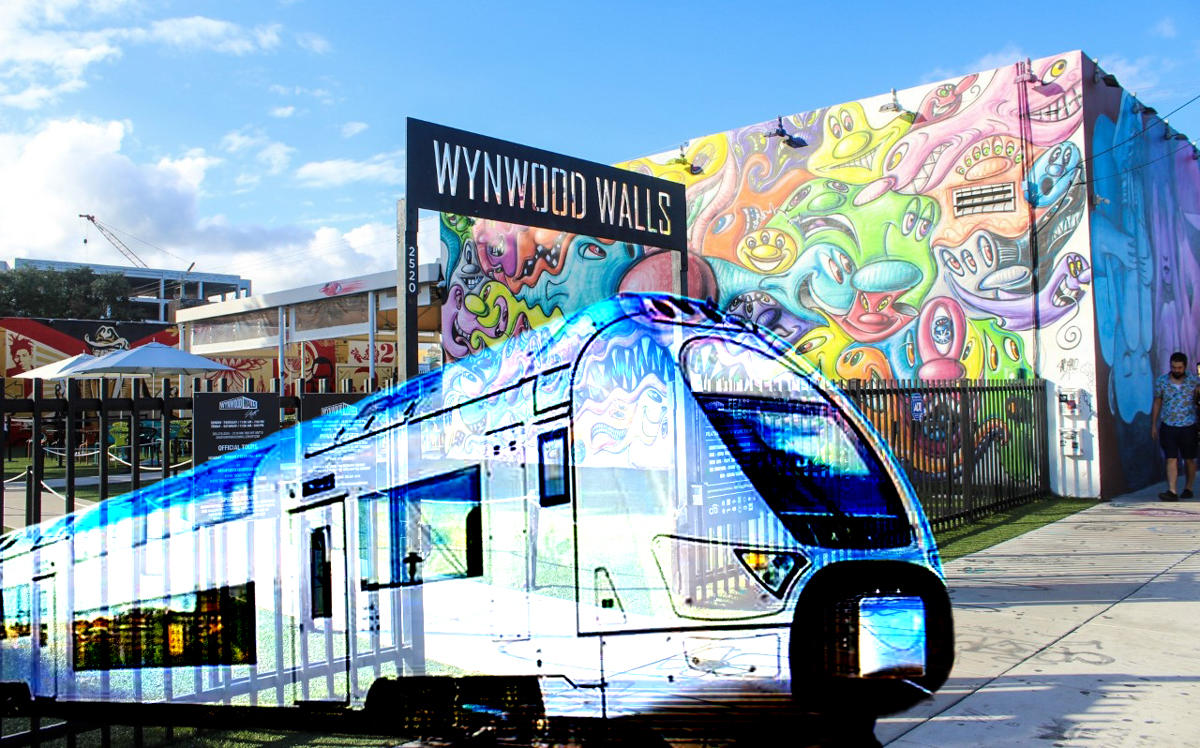UPDATED Oct. 11, 1 p.m.: Wynwood property owners are pushing for a train station at or near 29th Street, arguing that the area is poised for nearly 65 million square feet of additional development.
To prove that, the Wynwood Business Improvement District’s board retained planner Cesar Garcia-Pons to create a study on the potential development capacity within a half-mile radius of 36th Street and 29th Street by the Florida East Coast railroad tracks. The results of that study were revealed during a Wynwood BID meeting Wednesday.
BID board member David Polinsky said the study clearly illustrates that the Wynwood area has more than enough development potential to warrant a train station.
“When you look at the absolute numbers, we have the potential of becoming Miami’s second downtown,” Polinsky said. “Not by itself, but including the southern half of Edgewater.”
In fact, according to the study, the southern parts of Edgewater and Wynwood will be able to accommodate much more development than what can possibly be built near Midtown Miami and the Miami Design District, where a train station is now being contemplated.
The Florida East Coast tracks are now being utilized by Brightline, a train service owned and operated by real estate developer Florida East Coast Industries between the downtown areas of Miami, Fort Lauderdale, and West Palm Beach. Using $1.75 billion in tax exempt bonds, FECI hopes to extend that service to the Orlando airport by 2021.
Miami-Dade, Broward, and Palm Beach counties are also negotiating with FECI to create additional stations along the train tracks as part of a commuter service run by the South Florida Regional Transportation Authority, the public agency that oversees Tri-Rail. Also, in May, the Miami-Dade Transportation Planning Organization approved the concept of a “pilot” Tri-Rail train station at 36th Street just under the I-395 overpass.

Albert Garcia, vice-chair of the Wynwood BID, said board members only heard about the Tri-Rail pilot station at 36th Street through press reports. So, this past August, the Wynwood BID commissioned a $25,000 study analyzing development patterns.
“We believe that this is the area today, and even more so moving forward, where we are going to continue to see a higher concentration of residential density,” Garcia said.
Garcia-Pons said he looked at the maximum of what was allowed to be built under the city of Miami’s zoning code as well as what was likely to be buildable when factoring in land, setbacks, and other city code requirements. What he found is that there is now 11.9 million square feet of development located within a half-mile of 36th Street. Under current zoning codes, the maximum amount that could be built within a half-mile of 36th Street is 80.8 million square feet, although Garcia-Pons estimates that the maximum that can possibly be built is actually 48.3 million square feet.
In contrast, there’s already more than 14.3 million square feet of development within a half-mile of 29th Street. That same half-mile zone can accommodate up to 72 million square feet of development, while the city’s zoning codes allows a maximum of just under 123 million square feet of development, according to the study.
The Garcia-Pons study also estimated that at the maximum possible build-out, about 69,600 people will live within a half-mile of the 36th Street station, while another 18,300 people will be working within the 4.9 million square feet of commercial space. In contrast, the maximum build-out within a half mile of 29th Street can accommodate 105,000 residents, about 7.4 million square feet of commercial space, and 27,900 employees.
“There exists significantly higher development capacity in the vicinity of NE 29th Street than NE 36th Street,” Garcia-Pons wrote in his report to the Wynwood BID. “And, for the purpose of providing the greatest economic development benefits at the lowest cost to the public sector, a higher development capacity provides a sound statistical basis for siting a Midtown Tri-Rail Station nearer to 29th Street (closer to Wynwood/Edgewater/Midtown) than to NE 36th Street (Design District/Midtown).”
Garcia-Pons admits there’s an overlap for the 29th Street and 36th Street study areas. However, the study estimates that 300 percent more people are projected to live and work in the south — in Wynwood/Edgewater — than in the north near the Miami Design District.
Garcia said the study gives an excellent argument to place the train station even further south at 27th Street. “It’s the most logical location,” Garcia said, adding that the “cluster of property owners” there are generally in favor of a train station.
At the very least, Garcia said the report shows that the Edgewater-Wynwood area has only “scratched the surface” in terms of growth and that a dependable alternative mode of transportation will be needed. “It’s important that we get this right the first time,” he said.
